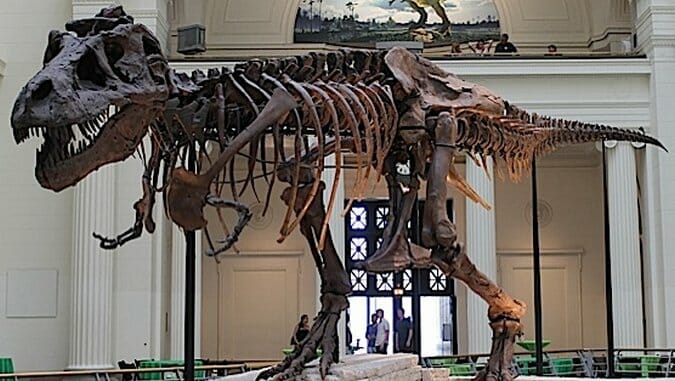
It’s hard, if not impossible, to believe that relic hunting really could be as thrilling, exciting or harrowing as depicted in the Raiders of the Lost Ark movies, after all, what is it that most paleontologist do but chisel and sweep away bits of stone from fossilized bone, right? And while that remains largely at the core of Todd Douglas Miller’s dino hunter doc, there’s a grisly eruption in the middle; a Brontosaurus big “What the Fuck” if you will, that shoots the somber dusting and digging off into a disturbing web of jurisdiction abuse, injustice and tangled land and property rights.
Back in 1990, the Black Hills Institute of Geographical Research in South Dakota, essentially a group of dino-loving paleontologists without Ph.Ds or academic grants, discovered the most complete and largest Tyrannosaurus Rex skeleton to date. Priorly, only twelve had been found—lucky number 13! The find was purely accidental, a flat tire, heavy fog and further unfortunate tidings had the crew heading to town to get the SUV fixed but one, Susan Hendrickson, decided to remain and mill about the weather-worn ravines of the Dakota Black Hills. That’s when lightning struck.
For two years, the crew worked tirelessly on excavating and extracting “Sue,” as the specimen was aptly named. Then one day, without warning or notice, thirty-five federal agents and the National Guard descended on the Institute to claim Sue and all records affiliated with her. Shock and awe. What exactly had the Larson brothers and the Black Hills Institute done wrong? According to U. S. attorney Kevin Shieffer, the bones had been taken from federal land without government permission—and that’s where things begin to get sticky. The Institute had given a check to the landowner Maurice Williams for five-thousand dollars to excavate Sue, but the land was Indian land and even though Williams was a tribe member, he was also, as the film has it, a notorious double dealer. Add to that Shieffer’s unrelenting pursuit of the case that kept ringing up more and more charges. “They wanted to put me away for more time than Jeffery Dahmer,” Peter Larson says of the three-hundred-plus year sentence he could face, “and he killed and ate thirteen people.”
Miller, who clearly puts his finger on a poignant topic, and knows how to shoot and edit with great clarity and effect (the dramatizations are minimal, effective and rendered without melodramatic leanings), misses on the arc. The meandering preamble of dust-brushing adventures and the unearthing of Sue consume too much screen time before the U.S. Government storms in and the real dance begins. Also missing is any testimony from Shieffer or Williams, or any of his affiliates. (Williams died in 2011.) The evidence against them is damning, but without journalistic evenness, something feels void or contrived. Then again, the trumped up charges themselves are so silly and laughable, as a tax payer, it’s hard to not register ire when you consider the sheer waste of resources and time diverted from more serious matters for righteous egomaniacal service.
In the end, and not to give too much away, Sue and the Institute’s journey bears just rewards even though a galactic auction at Sotheby’s and prison time with John Gotti remain in the course. The one consistent note that binds the shifting moods and action with pointed poetic poignance is Matt Morton’s sublime score. Miller’s use of Morton’s boon is so top-shelf, I can only think of the great documentary filmmaker Errol Morris and his collaborations with Phillip Glass on The Thin Blue Line and A Brief History of Time when trying to think of examples that carry greater discernible resonance.
Director: Todd Douglas Miller
Writer: Todd Douglas Miller
Starring: Peter Larson, Neal Larson, Robert Bakker, Susan Hendrickson
Release Date: Aug. 15, 2014
Tom Meek is a writer living in Cambridge, MA. His reviews, essays, short stories and articles have appeared in The Boston Phoenix, Paste Magazine, The Rumpus, Thieves Jargon, Charleston City Paper and SLAB literary journal. Tom is also a member of the Boston Society of Film Critics and rides his bike everywhere. You can follow him on Twitter